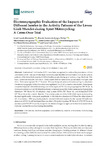Mostrar o rexistro simple do ítem
Electromyographic evaluation of the impacts of different insoles in the activity patterns of the lower limb muscles during sport motorcycling : a cross-over trial
| dc.contributor.author | Casado-Hernández, Israel | |
| dc.contributor.author | Becerro-de-Bengoa-Vallejo, Ricardo | |
| dc.contributor.author | Losa Iglesias, Marta Elena | |
| dc.contributor.author | López-López, Daniel | |
| dc.contributor.author | Rodríguez Sanz, David | |
| dc.contributor.author | Martínez Jiménez, Eva María | |
| dc.contributor.author | Calvo-Lobo, César | |
| dc.date.accessioned | 2019-06-18T16:21:17Z | |
| dc.date.available | 2019-06-18T16:21:17Z | |
| dc.date.issued | 2019 | |
| dc.identifier.citation | Casado-Hernández, I.; Becerro-de-Bengoa-Vallejo, R.; Losa-Iglesias, M.E.; López-López, D.; Rodríguez-Sanz, D.; Martínez-Jiménez, E.M.; Calvo-Lobo, C. Electromyographic Evaluation of the Impacts of Different Insoles in the Activity Patterns of the Lower Limb Muscles during Sport Motorcycling: A Cross-Over Trial. Sensors 2019, 19, 2249. | es_ES |
| dc.identifier.issn | 1424-8220 | |
| dc.identifier.uri | http://hdl.handle.net/2183/23249 | |
| dc.description.abstract | [Abstract] Customized foot insoles (CFI) have been recognized to reduce the prevalence of foot disorders in sport. The aim of this study was to evaluate the effect of four types of CFI on the activity patterns of the lower limb muscles (LLM) in healthy people during sport motorcycling. Methods: This was a cross-over trial (NCT03734133. Participants were recruited from an outpatient foot specialist clinic. Their mean age was 33 ± 5.14 years. While participants were sport motorcycling in a simulator, the electromyography (EMG) function was registered for LLM via surface electrodes. Participants completed separate tests while wearing one of four types of CFI: (1) only polypropylene (58° Shore D), (2) selective aluminum (60 HB Brinell hardness) in metatarsal and first hallux areas and polypropylene elsewhere (58° Shore D), (3) ethylene vinyl acetate (EVA) (52° Shore A), and (4) standard EVA (25° Shore A) as the control. Results: The activity patterns of the LLM while sport motorcycling showed significantly lower peak amplitude for the selective aluminum CFI than the other types of CFI. Conclusion: EMG amplitude peaks for several LLM were smaller for the hardest CFI (selective aluminum 60 HB Brinell hardness) than the other CFIs (polypropylene 58° Shore D, EVA 52° Shore A, and standard EVA 25° Shore A), except for the fibularis longus in right curves that is increased when the knee touches the road increasing the stability. | es_ES |
| dc.language.iso | eng | es_ES |
| dc.publisher | MDPI | es_ES |
| dc.relation.uri | https://doi.org/10.3390/s19102249 | es_ES |
| dc.rights | Creative Commons Attribution (CC BY 4.0) license | es_ES |
| dc.rights.uri | http://creativecommons.org/licenses/by/4.0/es/ | * |
| dc.subject | Foot insoles | es_ES |
| dc.subject | Electromyography | es_ES |
| dc.subject | Joint instability | es_ES |
| dc.subject | Muscle contractions | es_ES |
| dc.subject | Motorcycling | es_ES |
| dc.subject | Plantar pressure | es_ES |
| dc.title | Electromyographic evaluation of the impacts of different insoles in the activity patterns of the lower limb muscles during sport motorcycling : a cross-over trial | es_ES |
| dc.type | info:eu-repo/semantics/article | es_ES |
| dc.rights.access | info:eu-repo/semantics/openAccess | es_ES |
| UDC.journalTitle | Sensors | es_ES |
| UDC.volume | 19 | es_ES |
| UDC.issue | 10 | es_ES |
Ficheiros no ítem
Este ítem aparece na(s) seguinte(s) colección(s)
-
GI-UDISAP - Artigos [196]






